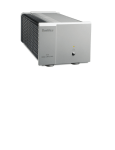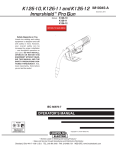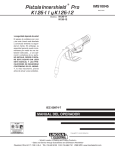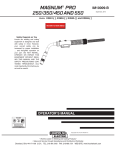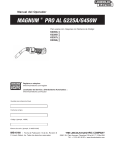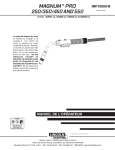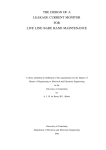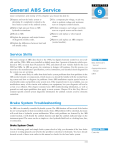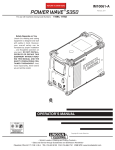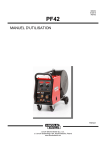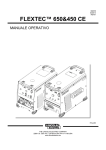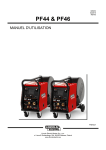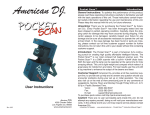Download Lincoln Electric MAGNUM 350 User's Manual
Transcript
RETURN TO MAIN MENU IM990 ™ MAGNUM PRO 350 and 550 FUME GUNS October, 2008 TYPE: K2649-1, K2650-1 Safety Depends on You Lincoln arc welding and cutting equipment is designed and built with safety in mind. However, your overall safety can be increased by proper installation ... and thoughtful operation on your part. DO NOT INSTALL, OPERATE OR REPAIR THIS EQUIPMENT WITHOUT READING THIS MANUAL AND THE SAFETY PRECAUTIONS CONTAINED THROUGHOUT. And, most importantly, think before you act and be careful. OPERATORʼS MANUAL Copyright © Lincoln Global Inc. • World's Leader in Welding and Cutting Products • • Sales and Service through Subsidiaries and Distributors Worldwide • Cleveland, Ohio 44117-1199 U.S.A. TEL: 216.481.8100 FAX: 216.486.1751 WEB SITE: www.lincolnelectric.com i i SAFETY WARNING CALIFORNIA PROPOSITION 65 WARNINGS For Gasoline Engines: The engine exhaust from For Diesel Engines: Diesel engine exhaust and this product contains chemicals known to the some of its constituents are known to the State State of California to cause cancer, birth defects, of California to cause cancer, birth defects, and or other reproductive harm. other reproductive harm. ARC WELDING CAN BE HAZARDOUS. PROTECT YOURSELF AND OTHERS FROM POSSIBLE SERIOUS INJURY OR DEATH. KEEP CHILDREN AWAY. PACEMAKER WEARERS SHOULD CONSULT WITH THEIR DOCTOR BEFORE OPERATING. Read and understand the following safety highlights. For additional safety information, it is strongly recommended that you purchase a copy of “Safety in Welding & Cutting - ANSI Standard Z49.1” from the American Welding Society, P.O. Box 351040, Miami, Florida 33135 or CSA Standard W117.2-1974. A Free copy of “Arc Welding Safety” booklet E205 is available from the Lincoln Electric Company, 22801 St. Clair Avenue, Cleveland, Ohio 44117-1199. BE SURE THAT ALL INSTALLATION, OPERATION, MAINTENANCE AND REPAIR PROCEDURES ARE PERFORMED ONLY BY QUALIFIED INDIVIDUALS. FOR ENGINE powered equipment. 1.h. To avoid scalding, do not remove the radiator pressure cap when the engine is hot. 1.a. Turn the engine off before troubleshooting and maintenance work unless the maintenance work requires it to be running. ____________________________________________________ 1.b.Operate engines in open, well-ventilated areas or vent the engine exhaust fumes outdoors. ____________________________________________________ 1.c. Do not add the fuel near an open flame welding arc or when the engine is running. Stop the engine and allow it to cool before refueling to prevent spilled fuel from vaporizing on contact with hot engine parts and igniting. Do not spill fuel when filling tank. If fuel is spilled, wipe it up and do not start engine until fumes have been eliminated. ____________________________________________________ 1.d. Keep all equipment safety guards, covers and devices in position and in good repair.Keep hands, hair, clothing and tools away from V-belts, gears, fans and all other moving parts when starting, operating or repairing equipment. ____________________________________________________ 1.e. In some cases it may be necessary to remove safety guards to perform required maintenance. Remove guards only when necessary and replace them when the maintenance requiring their removal is complete. Always use the greatest care when working near moving parts. ___________________________________________________ 1.f. Do not put your hands near the engine fan. Do not attempt to override the governor or idler by pushing on the throttle control rods while the engine is running. ELECTRIC AND MAGNETIC FIELDS may be dangerous 2.a. Electric current flowing through any conductor causes localized Electric and Magnetic Fields (EMF). Welding current creates EMF fields around welding cables and welding machines 2.b. EMF fields may interfere with some pacemakers, and welders having a pacemaker should consult their physician before welding. 2.c. Exposure to EMF fields in welding may have other health effects which are now not known. 2.d. All welders should use the following procedures in order to minimize exposure to EMF fields from the welding circuit: 2.d.1. Route the electrode and work cables together - Secure them with tape when possible. 2.d.2. Never coil the electrode lead around your body. 2.d.3. Do not place your body between the electrode and work cables. If the electrode cable is on your right side, the work cable should also be on your right side. 2.d.4. Connect the work cable to the workpiece as close as possible to the area being welded. ___________________________________________________ 1.g. To prevent accidentally starting gasoline engines while turning the engine or welding generator during maintenance work, disconnect the spark plug wires, distributor cap or magneto wire as appropriate. 2.d.5. Do not work next to welding power source. Mar ʻ95 ii ii SAFETY ELECTRIC SHOCK can kill. ARC RAYS can burn. 3.a. The electrode and work (or ground) circuits are electrically “hot” when the welder is on. Do not touch these “hot” parts with your bare skin or wet clothing. Wear dry, hole-free gloves to insulate hands. 4.a. Use a shield with the proper filter and cover plates to protect your eyes from sparks and the rays of the arc when welding or observing open arc welding. Headshield and filter lens should conform to ANSI Z87. I standards. 3.b. Insulate yourself from work and ground using dry insulation. Make certain the insulation is large enough to cover your full area of physical contact with work and ground. 4.b. Use suitable clothing made from durable flame-resistant material to protect your skin and that of your helpers from the arc rays. In addition to the normal safety precautions, if welding must be performed under electrically hazardous conditions (in damp locations or while wearing wet clothing; on metal structures such as floors, gratings or scaffolds; when in cramped positions such as sitting, kneeling or lying, if there is a high risk of unavoidable or accidental contact with the workpiece or ground) use the following equipment: • Semiautomatic DC Constant Voltage (Wire) Welder. • DC Manual (Stick) Welder. • AC Welder with Reduced Voltage Control. 4.c. Protect other nearby personnel with suitable, non-flammable screening and/or warn them not to watch the arc nor expose themselves to the arc rays or to hot spatter or metal. 3.c. In semiautomatic or automatic wire welding, the electrode, electrode reel, welding head, nozzle or semiautomatic welding gun are also electrically “hot”. 3.d. Always be sure the work cable makes a good electrical connection with the metal being welded. The connection should be as close as possible to the area being welded. 3.e. Ground the work or metal to be welded to a good electrical (earth) ground. 3.f. Maintain the electrode holder, work clamp, welding cable and welding machine in good, safe operating condition. Replace damaged insulation. 3.g. Never dip the electrode in water for cooling. 3.h. Never simultaneously touch electrically “hot” parts of electrode holders connected to two welders because voltage between the two can be the total of the open circuit voltage of both welders. 3.i. When working above floor level, use a safety belt to protect yourself from a fall should you get a shock. 3.j. Also see Items 6.c. and 8. FUMES AND GASES can be dangerous. 5.a. Welding may produce fumes and gases hazardous to health. Avoid breathing these fumes and gases.When welding, keep your head out of the fume. Use enough ventilation and/or exhaust at the arc to keep fumes and gases away from the breathing zone. When welding with electrodes which require special ventilation such as stainless or hard facing (see instructions on container or MSDS) or on lead or cadmium plated steel and other metals or coatings which produce highly toxic fumes, keep exposure as low as possible and below Threshold Limit Values (TLV) using local exhaust or mechanical ventilation. In confined spaces or in some circumstances, outdoors, a respirator may be required. Additional precautions are also required when welding on galvanized steel. 5. b. The operation of welding fume control equipment is affected by various factors including proper use and positioning of the equipment, maintenance of the equipment and the specific welding procedure and application involved. Worker exposure level should be checked upon installation and periodically thereafter to be certain it is within applicable OSHA PEL and ACGIH TLV limits. 5.c. Do not weld in locations near chlorinated hydrocarbon vapors coming from degreasing, cleaning or spraying operations. The heat and rays of the arc can react with solvent vapors to form phosgene, a highly toxic gas, and other irritating products. 5.d. Shielding gases used for arc welding can displace air and cause injury or death. Always use enough ventilation, especially in confined areas, to insure breathing air is safe. 5.e. Read and understand the manufacturerʼs instructions for this equipment and the consumables to be used, including the material safety data sheet (MSDS) and follow your employerʼs safety practices. MSDS forms are available from your welding distributor or from the manufacturer. 5.f. Also see item 1.b. AUG 06 iii iii SAFETY WELDING and CUTTING SPARKS can cause fire or explosion. 6.a. Remove fire hazards from the welding area. If this is not possible, cover them to prevent the welding sparks from starting a fire. Remember that welding sparks and hot materials from welding can easily go through small cracks and openings to adjacent areas. Avoid welding near hydraulic lines. Have a fire extinguisher readily available. 6.b. Where compressed gases are to be used at the job site, special precautions should be used to prevent hazardous situations. Refer to “Safety in Welding and Cutting” (ANSI Standard Z49.1) and the operating information for the equipment being used. 6.c. When not welding, make certain no part of the electrode circuit is touching the work or ground. Accidental contact can cause overheating and create a fire hazard. 6.d. Do not heat, cut or weld tanks, drums or containers until the proper steps have been taken to insure that such procedures will not cause flammable or toxic vapors from substances inside. They can cause an explosion even though they have been “cleaned”. For information, purchase “Recommended Safe Practices for the Preparation for Welding and Cutting of Containers and Piping That Have Held Hazardous Substances”, AWS F4.1 from the American Welding Society (see address above). 6.e. Vent hollow castings or containers before heating, cutting or welding. They may explode. CYLINDER may explode if damaged. 7.a. Use only compressed gas cylinders containing the correct shielding gas for the process used and properly operating regulators designed for the gas and pressure used. All hoses, fittings, etc. should be suitable for the application and maintained in good condition. 7.b. Always keep cylinders in an upright position securely chained to an undercarriage or fixed support. 7.c. Cylinders should be located: • Away from areas where they may be struck or subjected to physical damage. • A safe distance from arc welding or cutting operations and any other source of heat, sparks, or flame. 7.d. Never allow the electrode, electrode holder or any other electrically “hot” parts to touch a cylinder. 7.e. Keep your head and face away from the cylinder valve outlet when opening the cylinder valve. 7.f. Valve protection caps should always be in place and hand tight except when the cylinder is in use or connected for use. 7.g. Read and follow the instructions on compressed gas cylinders, associated equipment, and CGA publication P-l, “Precautions for Safe Handling of Compressed Gases in Cylinders,” available from the Compressed Gas Association 1235 Jefferson Davis Highway, Arlington, VA 22202. 6.f. Sparks and spatter are thrown from the welding arc. Wear oil free protective garments such as leather gloves, heavy shirt, cuffless trousers, high shoes and a cap over your hair. Wear ear plugs when welding out of position or in confined places. Always wear safety glasses with side shields when in a welding area. 6.g. Connect the work cable to the work as close to the welding area as practical. Work cables connected to the building framework or other locations away from the welding area increase the possibility of the welding current passing through lifting chains, crane cables or other alternate circuits. This can create fire hazards or overheat lifting chains or cables until they fail. 6.h. Also see item 1.c. 6.I. Read and follow NFPA 51B “ Standard for Fire Prevention During Welding, Cutting and Other Hot Work”, available from NFPA, 1 Batterymarch Park,PO box 9101, Quincy, Ma 022690-9101. 6.j. Do not use a welding power source for pipe thawing. FOR ELECTRICALLY powered equipment. 8.a. Turn off input power using the disconnect switch at the fuse box before working on the equipment. 8.b. Install equipment in accordance with the U.S. National Electrical Code, all local codes and the manufacturerʼs recommendations. 8.c. Ground the equipment in accordance with the U.S. National Electrical Code and the manufacturerʼs recommendations. Jan, 07 iv SAFETY PRÉCAUTIONS DE SÛRETÉ Pour votre propre protection lire et observer toutes les instructions et les précautions de sûreté specifiques qui parraissent dans ce manuel aussi bien que les précautions de sûreté générales suivantes: Sûreté Pour Soudage A LʼArc 1. Protegez-vous contre la secousse électrique: a. Les circuits à lʼélectrode et à la piéce sont sous tension quand la machine à souder est en marche. Eviter toujours tout contact entre les parties sous tension et la peau nue ou les vétements mouillés. Porter des gants secs et sans trous pour isoler les mains. b. Faire trés attention de bien sʼisoler de la masse quand on soude dans des endroits humides, ou sur un plancher metallique ou des grilles metalliques, principalement dans les positions assis ou couché pour lesquelles une grande partie du corps peut être en contact avec la masse. c. Maintenir le porte-électrode, la pince de masse, le câble de soudage et la machine à souder en bon et sûr état defonctionnement. d.Ne jamais plonger le porte-électrode dans lʼeau pour le refroidir. e. Ne jamais toucher simultanément les parties sous tension des porte-électrodes connectés à deux machines à souder parce que la tension entre les deux pinces peut être le total de la tension à vide des deux machines. f. Si on utilise la machine à souder comme une source de courant pour soudage semi-automatique, ces precautions pour le porte-électrode sʼapplicuent aussi au pistolet de soudage. 2. Dans le cas de travail au dessus du niveau du sol, se protéger contre les chutes dans le cas ou on recoit un choc. Ne jamais enrouler le câble-électrode autour de nʼimporte quelle partie du corps. 3. Un coup dʼarc peut être plus sévère quʼun coup de soliel, donc: a. Utiliser un bon masque avec un verre filtrant approprié ainsi quʼun verre blanc afin de se protéger les yeux du rayonnement de lʼarc et des projections quand on soude ou quand on regarde lʼarc. b. Porter des vêtements convenables afin de protéger la peau de soudeur et des aides contre le rayonnement de lʻarc. c. Protéger lʼautre personnel travaillant à proximité au soudage à lʼaide dʼécrans appropriés et non-inflammables. 4. Des gouttes de laitier en fusion sont émises de lʼarc de soudage. Se protéger avec des vêtements de protection libres de lʼhuile, tels que les gants en cuir, chemise épaisse, pantalons sans revers, et chaussures montantes. 5. Toujours porter des lunettes de sécurité dans la zone de soudage. Utiliser des lunettes avec écrans lateraux dans les zones où lʼon pique le laitier. iv 6. Eloigner les matériaux inflammables ou les recouvrir afin de prévenir tout risque dʼincendie dû aux étincelles. 7. Quand on ne soude pas, poser la pince à une endroit isolé de la masse. Un court-circuit accidental peut provoquer un échauffement et un risque dʼincendie. 8. Sʼassurer que la masse est connectée le plus prés possible de la zone de travail quʼil est pratique de le faire. Si on place la masse sur la charpente de la construction ou dʼautres endroits éloignés de la zone de travail, on augmente le risque de voir passer le courant de soudage par les chaines de levage, câbles de grue, ou autres circuits. Cela peut provoquer des risques dʼincendie ou dʼechauffement des chaines et des câbles jusquʼà ce quʼils se rompent. 9. Assurer une ventilation suffisante dans la zone de soudage. Ceci est particuliérement important pour le soudage de tôles galvanisées plombées, ou cadmiées ou tout autre métal qui produit des fumeés toxiques. 10. Ne pas souder en présence de vapeurs de chlore provenant dʼopérations de dégraissage, nettoyage ou pistolage. La chaleur ou les rayons de lʼarc peuvent réagir avec les vapeurs du solvant pour produire du phosgéne (gas fortement toxique) ou autres produits irritants. 11. Pour obtenir de plus amples renseignements sur la sûreté, voir le code “Code for safety in welding and cutting” CSA Standard W 117.2-1974. PRÉCAUTIONS DE SÛRETÉ POUR LES MACHINES À SOUDER À TRANSFORMATEUR ET À REDRESSEUR 1. Relier à la terre le chassis du poste conformement au code de lʼélectricité et aux recommendations du fabricant. Le dispositif de montage ou la piece à souder doit être branché à une bonne mise à la terre. 2. Autant que possible, Iʼinstallation et lʼentretien du poste seront effectués par un électricien qualifié. 3. Avant de faires des travaux à lʼinterieur de poste, la debrancher à lʼinterrupteur à la boite de fusibles. 4. Garder tous les couvercles et dispositifs de sûreté à leur place. Mar. ʻ93 v Thank You v for selecting a QUALITY product by Lincoln Electric. We want you to take pride in operating this Lincoln Electric Company product ••• as much pride as we have in bringing this product to you! CUSTOMER ASSISTANCE POLICY The business of The Lincoln Electric Company is manufacturing and selling high quality welding equipment, consumables, and cutting equipment. Our challenge is to meet the needs of our customers and to exceed their expectations. On occasion, purchasers may ask Lincoln Electric for advice or information about their use of our products. We respond to our customers based on the best information in our possession at that time. Lincoln Electric is not in a position to warrant or guarantee such advice, and assumes no liability, with respect to such information or advice. We expressly disclaim any warranty of any kind, including any warranty of fitness for any customerʼs particular purpose, with respect to such information or advice. As a matter of practical consideration, we also cannot assume any responsibility for updating or correcting any such information or advice once it has been given, nor does the provision of information or advice create, expand or alter any warranty with respect to the sale of our products. Lincoln Electric is a responsive manufacturer, but the selection and use of specific products sold by Lincoln Electric is solely within the control of, and remains the sole responsibility of the customer. Many variables beyond the control of Lincoln Electric affect the results obtained in applying these types of fabrication methods and service requirements. Subject to Change – This information is accurate to the best of our knowledge at the time of printing. Please refer to www.lincolnelectric.com for any updated information. Please Examine Carton and Equipment For Damage Immediately When this equipment is shipped, title passes to the purchaser upon receipt by the carrier. Consequently, Claims for material damaged in shipment must be made by the purchaser against the transportation company at the time the shipment is received. Please record your equipment identification information below for future reference. This information can be found on your equipment nameplate. Model Name and Sales Spec Number (K-xxx) _____________________________________ Date of Purchase __________________________________ Whenever you request replacement parts for or information on this equipment always supply the information you have recorded above. On-Line Product Registration - Register your machine with Lincoln Electric either via fax or over the Internet. • For faxing: Complete the form on the back of the warranty statement included in the literature packet accompanying this machine and fax the form per the instructions printed on it. • For On-Line Registration: Go to our WEB SITE at www.lincolnelectric.com. Choose “Quick Links” and then “Product Registration”. Please complete the form and submit your registration. Read this Operators Manual completely before attempting to use this equipment. Save this manual and keep it handy for quick reference. Pay particular attention to the safety instructions we have provided for your protection. The level of seriousness to be applied to each is explained below: WARNING This statement appears where the information must be followed exactly to avoid serious personal injury or loss of life. CAUTION This statement appears where the information must be followed to avoid minor personal injury or damage to this equipment. vi vi TABLE OF CONTENTS Page. Installation ..........................................................................................................Section A Technical Specifications ...............................................................................................A-1 Unpacking the Spool Gun ............................................................................................A-2 Fume Gun Familiarization .....................................................................................A-2 Assembly of Fume Gun Internal Parts...........................................................A-2, A-3 Safety Precautions .......................................................................................................A-3 Compatibility of Welding Machines and Wire Feeders ................................................A-3 Preparing the Fume Gun for Welding ..........................................................................A-3 Select and Install a Wire Feeder Connection K Kit .....................................................A-4 Select and Install Gun Consumable Parts ...................................................................A-5 Connect the Gun to the Wire Feeder...........................................................................A-6 Connect the Gun to the Fume Collection System .......................................................A-6 __________________________________________________________________________ OPERATION ...........................................................................................................Section B-1 Safety Precautions .......................................................................................................B-1 Product Description......................................................................................................B-1 Selecting or Changing the Trigger Position .................................................................B-2 Prepare the Fume Gun for Welding............................................................................ B-3 Load Specified Wire into the Gun............................................................................... B-3 Make the Weld .............................................................................................................B-3 __________________________________________________________________________ Accessories ......................................................................................................Section C-1 __________________________________________________________________________ Maintenance.........................................................................................................Section D Recommended Tools ...................................................................................................D-1 Routine Cleaning and Inspections ...............................................................................D-1 Gas Diffuser Replacement...........................................................................................D-1 Liner Assembly Cleaning or Replacement...................................................................D-1 Trigger and Accessory Switch Lead Routings .............................................................D-2 Gun Tube Replacement...............................................................................................D-3 Trigger Assembly Replacement ...................................................................................D-3 Gun Cable Assembly Replacement .....................................................................D-3, D-4 __________________________________________________________________________ Troubleshooting ..................................................................................................Section E How To Use Trouble Shooting Guide...........................................................................E-1 Troubleshooting.................................................................................................E-2 to E-5 __________________________________________________________________________ Parts List.................................................................................P-202-AB, P-202-AC Series __________________________________________________________________________ A-1 INSTALLATION TECHNICAL SPECIFICATIONS - MAGNUM PRO FUME GUNS MODELS K2649-1 Magnum Pro 350 amp Fume Gun K2650-1 Magnum Pro 550 amp Fume Gun WELDING PROCESSES GMAW (MIG), FCAW (also FCAW-SS), and FCAW-GS on ferrous base metals. FILLER WIRE ALLOYS Lincoln Super Arc, Super Glide, Innershield, and Outershield brand products. MAXIMUM WIRE SIZES (DIAMETERS) BY WELDING PROCESSES Both Models: 1/16 inch solid wire, GMAW K2649-1: 1/16 inch cored wire, FCAW and FCAW-GS K2650-1: 3/32 inch cored wire, FCAW and FCAW-GS RATED WELDING CURRENT AND DUTY CYCLE (10-MINUTE BASIS) K2649-1: 350 amps at 100%, all processes K2650-1: 550 amps at 100%, FCAW and FCAW-GS K2650-1: 450 amps at 100%, GMAW OVERALL WEIGHT K2649-1: 17.5 lbs. K2650-1: 20.0 lbs. CABLE LENGTH 15.0±0.2 feet METHOD OF GUIDANCE Semiautomatic (manually-guided) METHOD OF COOLING Air-cooled MAGNUM™ PRO 350 and 550 FUME GUNS A-1 A-2 A-2 INSTALLATION UNPACKING THE FUME GUN FIGURE A.2 Fume guns are factory-assembled and tested. Both gun models are shipped with a FCAW fume collection nozzle installed. Contact tips for 0.045 and 3/32” Diameter Wire are also installed on the 350 and 550 models, respectively. After opening the packaging, check that it contains 1 fully assembled fume gun, 1 GMAW fume collection nozzle, and 1 instruction manual (IM990). FUME GUN FAMILIARIZATION (550 amp model shown) GUN HANDLE (Figure A.1, Items 1 thru 10) 1. 1/8-Turn Fume Collection Nozzle (FCAW selfshielded version shown). 2. Heavy-Duty Slip-On Gas Nozzle Assembly. 3. Heavy-Duty Gas Diffuser Assembly with Magnum Pro Contact Tip. 4. Fume Tube Assembly with Integral Gun Hanger and Locking Collar. 5. Gun Hanger. 6. Handle Cooling Vents. 7. Trigger Assembly (SPST contacts, non-locking) with Finger Extension. Optional locking trigger assembly is available. 8. Swivel and Bellows Assemblies increase gun flexibility. 9. Locking Collar & Swivel allow Rapid Selection of Trigger-Down (shown) or Trigger-Up Positions. 10. Low-Profile Reusable Hose Clamps. FIGURE A.1 FEEDER END (Figure A.2, Items 1 thru 6) 1. Low-Profile Reusable Hose Clamps. 2. Incoming Connector Assembly: accommodates all standard Lincoln Magnum 300, 400, and 550 feeder connection K kits. 3. Gas Plug. 4. Vacuum Connection. 5. Modular Trigger Terminal Housing. 6. Vacuum Hose and Cover. Cover resists hot weld spatter; can be quickly and easily replaced with hook & eye closure along its entire length. ASSEMBLY OF FUME GUN INTERNAL PARTS (550 amp model shown) GUN HANDLE END (Figure A.3, Items 1 thru 7) 1. Two spiders support the handle and allow it to swivel around the gun tube assembly for Trigger-Down (shown) or Trigger-Up Positions. 2. Gun tube lock (with roll pin) prevents handle overrotation to avoid trigger lead damage. 3. Accessory switch leads (blue and black) may serve as spare trigger leads. 4. Trigger and accessory leads are routed to permit air flow and avoid lead damage. 5. One-piece copper electrical connector (cone) and gas hose barb fitting. 6. Copper cable nut for high electrical conductivity. 7. Two clamps (non-reusable) secure the cableʼs core tube to its hose barb fittings. FIGURE A.3 FEEDER END (Figure A.4, Items 1 thru 8) 1. Accessory switch leads (blue and black) may serve as spare trigger leads. 2. Trigger and accessory leads are routed to permit air flow and avoid lead damage. 3. One-piece copper electrical connector (cone) and gas hose barb fitting. 4. Copper cable nut for high electrical conductivity. 5. Two clamps (non-reusable) secure the cableʼs core tube to its hose barb fittings. MAGNUM™ PRO 350 and 550 FUME GUNS A-3 INSTALLATION 6. Split Y connector halves allow the gunʼs feeder end to be easily serviced. 7. Modular trigger terminal housing. May be easily changed to dual-procedure (DP) harness. 8. Incoming connector assembly accepts existing wire feeder connection K kits for Magnum 300, 400, and 550 guns. FIGURE A.4 A-3 COMPATIBILITY OF WELDING MACHINES AND WIRE FEEDERS 1. If the welding process requires welding gas (FCAWGS, GMAW, or MIG), then either the welding machine or feeder must be equipped with a gas solenoid valve to supply welding gas to the fume gun. 2. A gas mixer and regulator is required upstream of the gas solenoid valve to supply specified blends of welding gas at the specified flow rate. PREPARING THE FUME GUN FOR WELDING • Read all safety information: See the front of this instruction manual. Perform the following sections in the order shown. SAFETY PRECAUTIONS WARNING ELECTRIC SHOCK CAN KILL. • Turn the input power OFF at the welding power source before installation or changing drive rolls and/or guides. • Do not touch electrically live parts. • Magnum™ Pro Fume Guns When inching with the gun trigger, electrode and drive mechanism are "hot" to work and ground and could remain energized several seconds after the gun trigger is released. • Welding Machines, Wire Feeders, and Fume Extraction Equipment--Read and understand the equipmentsʼ instruction manuals and all hazard warnings on equipment and in the manuals. • Personal Protective Equipment--Wear the proper personal protective equipment for welding, including but not limited to, safety glasses, hearing protection, protective footwear, welding helmet, welding gloves, and welding leathers. • This product shall not be used in precipitation, or in wet or damp locations. • Use these fume guns only with all consumable parts properly installed in place. • Do not use these fume guns for arc-gouging. ------------------------------------------------------------------------ Prepare the Welding Machine and Wire Feeder as follows: 1. Read all safety information in all related instruction manuals. 2. Disconnect input power to the machine and the wire feeder. 3. Machine and feeder polarity settings: Set to match the electrodeʼs polarity requirement per the instruction manuals. 4. Gas selection: Connect gas supply to either the machineʼs or the feederʼs gas solenoid valve. Set the gas mixer (if required) to the specified gas composition. 5. Gas flow rate: Set the supply regulator to deliver a gas flow rate of 50 to 70 SCFH thru the fume gun. MAGNUM™ PRO 350 and 550 FUME GUNS A-4 INSTALLATION A-4 SELECT AND INSTALL A WIRE FEEDER CONNECTION K KIT TABLE A.1 Wire Feeder Data Kit No. for Gun Model 350 amp 550 amp Manufacturer Model LN-7, LN-8, & LN-9 series; LN-25 (0.052 max.); none K466-1 LN-742 none LN-7, LN-8, & LN-9 series; LN-25 (1/16 min.); LN-742 K466-8 none LF-72, LN-74 K466-10 Lincoln Electric Series 10 feeders; LN-15; PF-10M; PF-15M none K466-10 none Power MIG & Wirematic series feeders K466-6 K613-1 LN-7, LN-8, & LN-9 series (0.052 max.) none K613-6 LN-8, & LN-9 series (1/16 min.) none K613-7 Series 10 feeders; PF-10M none Tweco Adapted No. 2, 3, and 4 guns K466-2 K613-2 Intellimatic, Side Kick, D-51A, Porta-MIG, Millermatic 130, 300 & 35 S-42GL, S-52A & S-54A Miller K466-3 K613-3 Swing Arc –Dual & Single, S-22, S-32S, 52D, 54D, 54E, 60 & 70 series Dualmatic 27/70, H3S, H4S, H6S K466-4 K613-4 Mega-Conds 27, 44, 45, 70, 70S Hobart 2000 series; 17 Hefty K466-7 K613-5 Digamig, EH1, 5 & 11, SEH-4 & 5, SWM11 & 11B, 12, K466-5 none ESAB 13, 23, 24, 25, 26, 35, VAM2 Note that the Magnum Pro 350 and 550 amp fume guns use the same connection kits as the Magnum 300 / 400 and 550 MIG gun products (non-Fastmate), respectively. MAGNUM™ PRO 350 and 550 FUME GUNS A-5 A-5 INSTALLATION SELECT AND INSTALL GUN CONSUMABLE PARTS 1. LINER ASSEMBLY 4. FUME COLLECTION NOZZLE (See Figure A.6) Figure A.6 TABLE A.2 KP Nos. for Gun Model Wire Diameter 550 amp 350 amp 0.035 KP45-3545-15 KP44-3545-15 0.045 KP45-3545-15 KP44-3545-15 0.052 KP45-116-15 KP44-116-15 1/16 KP45-116-15 KP44-116-15 5/64 KP45H-332-15 none 3/32 KP45H-332-15 none Note that the Magnum Pro 350 and 550 amp fume guns use the same liner assemblies as the Magnum 300 and 550 MIG gun products, respectively. • Select the fume collection nozzle to match the welding process. 2. CONTACT TIP (See Figure A.5) Gun Wire Model Diameter 0.035 0.045 Both 0.052 1/16 5/64 550 amp 3/32 TABLE A.3 KP Numbers 10-piece pack 100-piece pack KP2745-035 KP2745-045 KP2745-052 KP2745-116 KP2745-564 KP2745-332 KP2745-035-B100 KP2745-045-B100 KP2745-052-B100 KP2745-116-B100 KP2745-564-B100 KP2745-332-B100 3. GAS DIFFUSER, CONTACT TIP AND GAS DIFFUSER Figure A.5 • Twist counter clockwise to begin removing the fume collection nozzle (right-hand thread convention). • Pull to finish removing the fume collection nozzle. Install nozzle by pushing then twisting clockwise. Do not over-tighten the nozzle. PERIODIC REPLACEMENT PARTS Gun tube assembly Fume tube assembly Vacuum hose cover Liner assemblies MAGNUM™ PRO 350 and 550 FUME GUNS KP2738-1 KP2739-1 KP2736-1 See Table A.2 A-6 A-6 INSTALLATION 5. REMOVING THE FUME TUBE ASSEMBLY (See figure A.7) CONSUMABLE PARTS Contact tips See Table A.3 KP2747-1 Gas diffuser assembly Gas nozzle assembly, 5/8 inch opening KP2743-2-62R Fume collection nozzles See Figure A.6 Figure A.7 CONNECT THE GUN TO THE WIRE FEEDER 1. Make sure that the gun locking knob is loosened. Insert the gun into the gun conductor block and tighten the gun locking knob. • Loosen locking collar (counter clockwise, right-hand threads) on fume tube. Gas diffuser may remain in place. 2. Make the gas connection from the feeder to the gun (if required). 3. Plug the trigger harness into the gunʼs Y-connector. Plug the trigger harnessʼ connector into the receptacle on the front of the feeder. CONNECT THE GUN TO THE FUME COLLECTION SYSTEM 1. Speed setting for Lincoln Miniflex system: “High” is preferred for maximum fume collection. • Slide the fume tube out of the gun handle. 2. Automatic / Manual setting (where available): Set to “Manual” mode so that fume collection system will continue running after welding. This ensures maximum cooling of the gun. Fume collection system or gate valve to the gun may be shut off or closed after the gun has cooled for 10 minutes since the last weld. • Slide the fume tube off of the gun tube. • Fume tube removed. MAGNUM™ PRO 350 and 550 FUME GUNS OPERATION B-1 B-1 SAFETY PRECAUTIONS PRODUCT DESCRIPTION Read and understand this entire section before operating the machine. • Reliable, industrial-quality welding gun primarily for experienced welders. • In a few seconds the trigger may be rotated 180 degrees to a trigger “up” or “down” position by the welding operator. Neither tools nor gun disassembly is required. • GMAW or FCAW fume collection nozzles may be selected for fume collection. They can be easily and quickly installed or removed by hand. The design tolerates dirt accumulation and heat without seizing in place. • Optional dual-procedure switch and modular trigger connection to wire feeder. • Spoiler: An optional ergonomic hand grip. • Gun cable compactly integrates welding current, wire feeding, and gas supply with gun control functions. WARNING ELECTRIC SHOCK can kill. • Do not touch electrically live parts or electrode with skin or wet clothing. • Insulate yourself from work and ground. • Always wear dry insulating gloves. • Read and follow “Electric Shock Warnings” in the Safety section if welding must be performed under electrically hazardous conditions such as welding in wet areas or on or in the workpiece. FUMES AND GASES can be dangerous. • Keep your head out of fumes. • Use ventilation or exhaust to remove fumes from breathing zone. WELDING SPARKS can cause fire or explosion • Keep flammable material away. • Do not weld on containers that have held combustibles. ARC RAYS can burn. • Wear eye, ear and body protection. Observe additional Safety Guidelines detailed in the beginning of this manual. MAGNUM™ PRO 350 and 550 FUME GUNS B-2 OPERATION SELECTING OR CHANGING THE TRIGGER POSITION (See Figure B.1) FIGURE B.1 1. Trigger-down position shown. 4. Tighten locking collar (clockwise). 2. Loosen Locking Collar (counter clockwise, righthand threads on fune tube. 5. Trigger-up position shown. 3, Hold fume tube stationary. Rotate handle Counterclockwise (counter clockwise). MAGNUM™ PRO 350 and 550 FUME GUNS B-2 B-3 OPERATION PREPARE THE FUME GUN FOR WELDING (Also See Installation Section) • Read all safety information in this Instruction Manual. • Verify that input power to the machine and the wire feeder is disconnected. LOAD SPECIFIED WIRE INTO THE GUN 1. Refer to welding wire literature for proper machine and feeder settings and proper usage. 2. Select specified welding wire. B-3 7. Protect the eyes and pull the trigger to begin welding. 8. Adjust the hand travel speed of the gun to achieve a proper weld. The emerging wire should stay within the molten puddle and not overrun it. This speed also should not be so slow that either the workpiece excessively melts, or that the weld bead becomes excessively large. 9. Release the trigger to stop welding. 10. Fume collection system or gate valve to the gun may be shut off or closed after the gun has cooled for 10 minutes since the last weld. 3. Load specified welding wire into the feeder. 4. Connect the gun to the welding machine per the Installation Section. 5. Reconnect power to the welding machine and wire feeder. 6. Feed wire through the gun and contact tip. It may be necessary to temporarily remove the contact tip to feed wire. Reinstall the tip if it was removed. MAKE THE WELD 1. Obtain and use the proper personal protective equipment for welding. See Safety Precautions in the Installation Section and at the beginning of this Instruction Manual. 2. Cut off the wire so that it extends about 1/4 inches from the contact tip. 3. Verify that the input power is connected to the machine and wire feeder. 4. Flip the machineʼs and feederʼs power switches to “on”. 5. Flip the fume extractorʼs power switch to “on”. Set the extractor to the correct operating speed. 6. CTWD (contact tip to work distance) and push (GMAW) or drag (FCAW) angle: Read the filler wire instructions to determine the correct CTWD and angle values for the selected welding procedure and position the gun accordingly. The protruding welding wire should not contact the workpiece. MAGNUM™ PRO 350 and 550 FUME GUNS C-1 ACCESSORIES ACCESSORIES OR OPTIONS • Optional dual-procedure switch and modular trigger connection to wire feeder. • Spoiler: An optional ergonomic hand grip. MAGNUM™ PRO 350 and 550 FUME GUNS C-1 D-1 MAINTENANCE RECOMMENDED TOOLS • Adjustable-jaw pliers • Welding pliers (optional) • 7/16 inch open-end wrench (gas diffuser, gas plug or fitting, gun tube wrench flats) • 1-1/8 inch open-end wrench (incoming connector) • 9/64 inch allen wrench (handle screws) • 5/64 inch allen wrench (liner set screw) • 3/4 inch open-end wrench (cable cone) • 7/8 inch open-end wrench (cable nut) • 3/32 inch dia. drift (gun tube lock removal) Hammer • Wire cutter • Wire stripper • Needlenose pliers • External snap ring pliers (gun tube spiders) • Terminal crimping tool • Flashlight • Hand-held electrical meter • Tape measure or 6-inch scale • Oetiker clamp tool • Oetiker clamp crimping tool ROUTINE CLEANING AND INSPECTIONS D-1 LINER ASSEMBLY CLEANING OR REPLACEMENT • Clean out old liner by straightening out the gun and gently blowing out the liner with shop air or obtain a new liner assembly. • Replacement liner assemblies are factory-made to a length longer than the gun. Cutting is required. 1. Straighten out the gun. Remove fume collection nozzle, gas nozzle, contact tip, and gas diffuser (See Liner Assembly Cleaning or Replacecment, Installation Section). 2. Loosen liner set screw and remove old liner by sliding it rearward from the gun. 3. Install new liner and retighten set screw. Use care not to over-tighten set screw or liner will be deformed and damaged. 4. Cut new liner to length, measuring 0.500 to 0.625 inches from the end of the gun tube. Deburr the end of the liner. 5. Reinstall gas diffuser by threading into place. Tighten to 41 to 47 in.-lbs. with wrench. 6. Reinstall contact tip, gas nozzle, and fume collection nozzle. 1. Clean out fume collection nozzle, fume tube assembly, and handle cooling slots 2. Wipe off dust and debris 3. Clean out the inside of the liner assembly (See Liner Assembly Cleaning or Replacecment, Installation Section) 4. Check that the gun tube and incoming connector assembly are properly tightened to the cable assembly 5. Replace any warning or product identification decals that have become illegible GAS DIFFUSER REPLACEMENT (See Select and Install Consumable Parts, Installation Section) This part may need to be replaced if it has accumulated excessive spatter and cannot be cleaned: 1. Remove fume collection nozzle, gas nozzle, and contact tip. 2. Install gas diffuser and thread into place in gun tube. Tighten diffuser to 41 to 47 in.-lbs. with wrench. MAGNUM™ PRO 350 and 550 FUME GUNS D-2 MAINTENANCE TRIGGER AND ACCESSORY SWITCH LEAD ROUTINGS (Gun Handle, See Figure D.1) • • • Route the trigger (red and white) and accessory (blue and black) leads following the steps shown below. Proper routing: Provides adequate slack so that the handle can rotate to its trigger-up or trigger-down positions without damaging or disconnecting the leads. Avoids fume air flow blockage and unnecessary restrictions through the handle. 1. Start with trigger and gun tube in the trigger-down position (See Figure B.1, Operation Section). Run sleeved accessory switch leads (blue and black) parallel to gun centerline. Rear end of sleeving (right-side in photo) is even with copper cable nut end. 2. Run sleeved trigger leads (red and white) parallel to gun centerline and next to accessory leads sleeving. Rear end of sleeving (right-side in photo) is even with copper cable nut end. D-2 3. Remove slack in both pairs of control leads here. 4. Secure both sleeved groups to the copper cable cone with a cable tie. Do not attach any unsleeved leads here. 5. Route trigger leads in a loop over and then underneath the gun tube. 6. Trigger leads emerge from under the gun tube, pass thru lead slot in gun handle, and then connect to the trigger. Either lead may be connected to either trigger pin (non-polarized connections). 7. Route accessory leads under and then over the gun tube. Secure free ends of both leads to the gun tube with a cable tie. When reassembling the gun, be careful not to pinch any leads between gun handle halves. FIGURE D.1 MAGNUM™ PRO 350 and 550 FUME GUNS D-3 MAINTENANCE GUN TUBE REPLACEMENT • Replace if worn from use; for example, if gas diffuser threads are deforming. 1. Remove consumables per this section, Gas Diffuser Replacement. 2. Remove swivel assembly at rear of handle (ccw, right-hand threads), remove fume tubeʼs locking collar from handle, and remove left side of handle. 3. Use snap ring pliers to remove both spiders from the old gun tube. Use hammer and drift to remove the gun tube lock from the old gun tube. 4. Obtain a new replacement gun tube. 5. Install spiders and gun tube lock onto the new gun tube. 6. Install new gun tube to the gun end of the gun cable. Tighten gun tube to gun cable with 10 to 12 ft.-lbs. of torque. 7. Reassemble gun. Route the control leads inside of gun handle per this section, Trigger and Accessory Switch Lead Routing. Be careful not to pinch any leads between gun handle halves. TRIGGER ASSEMBLY REPLACEMENT • There are no serviceable or maintainable parts inside of the trigger. 1. Remove swivel assembly at rear of handle (counter clockwise, right-hand threads), remove fume tubeʼs locking collar from handle, and remove left side of handle. 2. Slide trigger out of right handle half. Disconnect red and white leads from trigger. Use care to prevent damage to electrical leads and the terminals. 3. Connect red and white leads to the new trigger. Either lead may be connected to either trigger pin (non-polarized connections). D-3 GUN CABLE ASSEMBLY REPLACEMENT • In general, the 350 and 550 gun cables have no serviceable or maintainable parts. Here are the only types of cable service that may be performed without removing or replacing an entire gun cable: • Replace both “o-rings” on the gunʼs power and gas connector (see Table A.1, Installation Section). • Repair the gunʼs four #19 AWG control leads by splicing and soldering them back together, and then reinsulating them with heat-shrink tubing. See Figure A.3 Installation Section and Trigger Assembly Replacement for a description of the connections. • Otherwise, a damaged gun cable should be replaced as follows: 1. Remove liner assembly per this section Liner Assembly Cleaning or Replacement. 2. Remove gun tube assembly per this section Gun Tube Replacement. Do not remove spiders or gun tube lock. 3. Disconnect gun cableʼs red and white control leads from trigger assembly. 4. Disconnect gun cableʼs blue and black control leads from optional accessory switch (if so equipped). 5. Disassemble the Y connector halves as follows. See Figure A.2 and A.4 Installation Section as a guide: • Disconnect the gunʼs Y connector from the vacuum source. • Use the Oetiker tool to remove the gunʼs clamp from its vacuum hose. • Slide the clamp and hose off of the Y connectorʼs inlet. • Remove the 2 screws from the Y connectorʼs modular trigger terminal housing. • Remove the 3 screws from the Y connector. • Separate the Y connector halves. • Remove the modular trigger terminal housing halves and separate them. 4. Slide new trigger into place and reassemble the gun. Be careful not to pinch any leads between gun handle halves. MAGNUM™ PRO 350 and 550 FUME GUNS D-4 MAINTENANCE 6. Remove the two trigger terminals from the modular trigger terminal housing. 7. Remove the incoming connector assembly (see Item 8 Figure A.4, Installation Section) from the gun cable. 8. Remove the damaged gun cable by sliding it rearward from the vacuum hose. 9. Install the new gun cable by sliding it forward through the vacuum hose. 10. Reassemble gun by reversing steps 1 through 7, noting the following: • Route trigger leads per this section Trigger and Accessory Switch Lead Routings (see figure D.1). • Installation torques for both the incoming connector and gun tube assemblies: 10 to 12 ft.-lbs.. • The order of connection of the trigger terminals (red and white leads) to the trigger assembly or in the Y connector is unimportant (non-polarized connections). • Reassemble the Y connector by reversing steps shown in 5. • Install a new liner if it does not meet the cut dimensional range given per this section Liner Assembly Cleaning or Replacement. MAGNUM™ PRO 350 and 550 FUME GUNS D-4 E-1 TROUBLESHOOTING E-1 HOW TO USE TROUBLESHOOTING GUIDE WARNING Service and Repair should only be performed by Lincoln Electric Factory Trained Personnel. Unauthorized repairs performed on this equipment may result in danger to the technician and machine operator and will invalidate your factory warranty. For your safety and to avoid Electrical Shock, please observe all safety notes and precautions detailed throughout this manual. __________________________________________________________________________ This Troubleshooting Guide is provided to help you locate and repair possible machine malfunctions. Simply follow the three-step procedure listed below. Step 1. LOCATE PROBLEM (SYMPTOM). Look under the column labeled “PROBLEM (SYMPTOMS)”. This column describes possible symptoms that the machine may exhibit. Find the listing that best describes the symptom that the machine is exhibiting. Step 3. RECOMMENDED COURSE OF ACTION This column provides a course of action for the Possible Cause, generally it states to contact your local Lincoln Authorized Field Service Facility. If you do not understand or are unable to perform the Recommended Course of Action safely, contact your local Lincoln Authorized Field Service Facility. Step 2. POSSIBLE CAUSE. The second column labeled “POSSIBLE CAUSE” lists the obvious external possibilities that may contribute to the machine symptom. CAUTION If for any reason you do not understand the test procedures or are unable to perform the tests/repairs safely, contact your Local Lincoln Authorized Field Service Facility for technical troubleshooting assistance before you proceed. MAGNUM™ PRO 350 and 550 FUME GUNS E-2 E-2 TROUBLESHOOTING Observe all Safety Guidelines detailed throughout this manual PROBLEMS (SYMPTOMS) POSSIBLE CAUSE RECOMMENDED COURSE OF ACTION PROBLEMS No wire feed occurs when trigger is 1. Machine is switched off or unplugged. 1. Switch on or plug in machine. pulled 2. Install full spool of specified wire. 2. Out of wire. 3. Contact tip burnback. 3. Replace contact tip. 4. Fully or partially blocked gun liner 4. Remove and clean or replace gun liner, (See Maintenance Section). 5. Bird nest. 5. Cut out bird nest, reload wire, and check for proper wire alignment. 6. Defective trigger (contacts open or 6. Replace trigger (See Maintenance Section) dirty). 7. Defective trigger circuit in gun. 7. Disconnect gun from machine and check trigger circuit for continuity. 8. No motor voltage or current from 8. See Troubleshooting section in welding machineʼs or wire feederʼs instrucmachine. tion manual. 9. Contact tip size too small for wire 9. Replace contact tip with one that is the correct size. diameter used. Sluggish wire feed when trigger is pulled 1. Drive roll is worn or galled. 1. Clean drive roll or replace drive roll. 2. Machineʼs wire feed speed setting is 2. Increase wire feed speed. too low. 3. Wire is obstructed somewhere along 3. Check for obstructions: remove any wire shavings; remove kinked wire; the wire feed path in the gun. remove and clean or replace gun tube liner (See Maintenance Section ). 4. Low motor voltage. 4. See Troubleshooting section in welding machineʼs instruction manual. CAUTION If for any reason you do not understand the test procedures or are unable to perform the tests/repairs safely, contact your Local Lincoln Authorized Field Service Facility for technical troubleshooting assistance before you proceed. MAGNUM™ PRO 350 and 550 FUME GUNS E-3 E-3 TROUBLESHOOTING Observe all Safety Guidelines detailed throughout this manual PROBLEMS (SYMPTOMS) POSSIBLE CAUSE RECOMMENDED COURSE OF ACTION PROBLEMS Intermittent wire feed when trigger is 1. Drive roll has become galled. pulled. 1. Remove and then clean or replace drive roll. (See Maintenance Section) 2. Wire has become kinked along its feed 2. Manually pull wire slowly thru gun until path. unkinked wire emerges. Poor fume extraction. 1. Fume powder deposits are blocking off 1. Remove the powdered deposits. gun passages at the fume collection nozzle or fume tube. 2. Excessive air currents. 2. Block off air drafts. 3. Gun has excessive air leaks. 3. Check for loose hose clamps or detached hoses. 4. Trigger and accessory switch leads 4. Reroute leads (See Maintenance are blocking fume air flow. Section). 5. Fume extraction switched off. equipment is 5. Switch on or plug in extraction equipment. 6. Fume extraction equipment is non- 6. See Troubleshooting section in extracfunctional. torʼs instruction manual. 7. Fume extraction blocked filters. equipment has 7. Clean or replace filters per equipment instructions. 8. Lincoln Miniflex extractor is set to low 8. Set to high speed. speed. 9. Vacuum hose is partially or completely 9. Attempt to straighten out hose or flattened or blocked. remove blockage; otherwise replace hose. 10. Vacuum hose is punctured or torn. 10. Punctures: Patch hose with tape Tears: Replace hose. Frequent occurrence of contact tip burn- 1. Improper welding parameters or tech- 1. See welding wire literature for proper back. nique (example: ESO is too short). settings 2. Wire may be feeding intermittently. 2. See symptoms on intermittent or sluggish wire feed CAUTION If for any reason you do not understand the test procedures or are unable to perform the tests/repairs safely, contact your Local Lincoln Authorized Field Service Facility for technical troubleshooting assistance before you proceed. MAGNUM™ PRO 350 and 550 FUME GUNS E-4 E-4 TROUBLESHOOTING Observe all Safety Guidelines detailed througout this manual PROBLEMS (SYMPTOMS) POSSIBLE AREAS OF MISADJUSTMENTS RECOMMENDED COURSE OF ACTION PROBLEMS Frequent occurrence of contact tip burnback. 1. Improper welding parameters or technique (example: ESO is too short). 1. See welding wire literature for proper settings 2. Wire may be feeding intermittent- 2. See symptoms on intermittent or sluggish wire feed ly. Poor weld bead appearance (porosi- 1. No gas flow. ty or dull gray oxidized surface). 2. Low gas flow. 1. See symptom “Low or no gas flow”. 2. See symptom “Low or no gas flow”. 3. Improper or contaminated shield- 3. Check that the gas supplyʼs labeling reads 100% argon. ing gas. Temporarily use alternate, known gas supply and check for appearance improvement. 4. Welding in a windy environment. 4. Erect a wind shield or move to a non-windy location before welding 5. Improper electrode polarity. 5. Reconnect machineʼs welding output to proper electrode polarity 6. Improper welding parameters or technique 6. See welding wire literature for proper settings CAUTION If for any reason you do not understand the test procedures or are unable to perform the tests/repairs safely, contact your Local Lincoln Authorized Field Service Facility for technical troubleshooting assistance before you proceed. MAGNUM™ PRO 350 and 550 FUME GUNS E-5 E-5 TROUBLESHOOTING Observe all Safety Guidelines detailed throughout this manual PROBLEMS (SYMPTOMS) POSSIBLE CAUSE RECOMMENDED COURSE OF ACTION PROBLEMS Low or no shielding gas flow. 1. Out of gas. 1. Check that an adequate gas supply is available. 2. Gas supply is turned off or discon- 2. Check that all gas supply valves nected. are open. 3. Gas supply flow regulator is 3. Check that gas flow is set between improperly set. 50 to 70 SCFH. 4. Machineʼs gas solenoid valve has 4. See machineʼs instruction manual. malfunctioned. 5. Blockage in gun along gas path. 5. Gently blow out debris from core tube. 6. Gun cable kinked or flattened. 6. Attempt to straighten out cable, or replace cable. 7. Blockage due to excessive spatter 7. Clean or replace gas cone or gas accumulation on gas cone or gas diffuser. diffuser. 8. Excessive gas leakage from sup- 8. Find and repair all leaks. ply. 10. Gas leakage at gun-to-feeder 10. Damaged o-rings: replace both connection. seals. Gun connector not fully inserted into machine. (See Maintenance Section). Wire feeder runs or begins feeding wire without pulling the gun trigger. 1. Defective trigger, (contacts closed 1. Replace trigger. or dirty). Maintenance Section). (See 2. Defective (closed) trigger circuit in 2. See machineʼs instruction manual the welding machine. 3. Trigger lead(s) inside gun cable 3. Damaged control leads along are shorted together or commonly cable; repair if possible. shorted to either welding or accesOtherwise, replace gun cable. sory switch circuits CAUTION If for any reason you do not understand the test procedures or are unable to perform the tests/repairs safely, contact your Local Lincoln Authorized Field Service Facility for technical troubleshooting assistance before you proceed. MAGNUM™ PRO 350 and 550 FUME GUNS NOTES MAGNUM™ PRO 350 and 550 FUME GUNS NOTES MAGNUM™ PRO 350 and 550 FUME GUNS ● Do not touch electrically live parts or WARNING Spanish AVISO DE PRECAUCION French ATTENTION German WARNUNG Portuguese ATENÇÃO ● Keep flammable materials away. ● Wear eye, ear and body protection. ● Mantenga el material combustible ● Protéjase los ojos, los oídos y el electrode with skin or wet clothing. ● Insulate yourself from work and ground. ● No toque las partes o los electrodos bajo carga con la piel o ropa mojada. ● Aislese del trabajo y de la tierra. ● Ne laissez ni la peau ni des vête- ments mouillés entrer en contact avec des pièces sous tension. ● Isolez-vous du travail et de la terre. ● Berühren Sie keine stromführenden Teile oder Elektroden mit Ihrem Körper oder feuchter Kleidung! ● Isolieren Sie sich von den Elektroden und dem Erdboden! ● Não toque partes elétricas e elec- trodos com a pele ou roupa molhada. ● Isole-se da peça e terra. fuera del área de trabajo. ● Gardez à l’écart de tout matériel inflammable. ● Entfernen Sie brennbarres Material! cuerpo. ● Protégez vos yeux, vos oreilles et votre corps. ● Tragen Sie Augen-, Ohren- und Kör- perschutz! ● Mantenha inflamáveis bem guarda- dos. ● Use proteção para a vista, ouvido e corpo. Japanese Chinese Korean Arabic READ AND UNDERSTAND THE MANUFACTURER’S INSTRUCTION FOR THIS EQUIPMENT AND THE CONSUMABLES TO BE USED AND FOLLOW YOUR EMPLOYER’S SAFETY PRACTICES. SE RECOMIENDA LEER Y ENTENDER LAS INSTRUCCIONES DEL FABRICANTE PARA EL USO DE ESTE EQUIPO Y LOS CONSUMIBLES QUE VA A UTILIZAR, SIGA LAS MEDIDAS DE SEGURIDAD DE SU SUPERVISOR. LISEZ ET COMPRENEZ LES INSTRUCTIONS DU FABRICANT EN CE QUI REGARDE CET EQUIPMENT ET LES PRODUITS A ETRE EMPLOYES ET SUIVEZ LES PROCEDURES DE SECURITE DE VOTRE EMPLOYEUR. LESEN SIE UND BEFOLGEN SIE DIE BETRIEBSANLEITUNG DER ANLAGE UND DEN ELEKTRODENEINSATZ DES HERSTELLERS. DIE UNFALLVERHÜTUNGSVORSCHRIFTEN DES ARBEITGEBERS SIND EBENFALLS ZU BEACHTEN. ● Keep your head out of fumes. ● Use ventilation or exhaust to ● Turn power off before servicing. ● Do not operate with panel open or guards off. remove fumes from breathing zone. ● Los humos fuera de la zona de res- piración. ● Mantenga la cabeza fuera de los humos. Utilice ventilación o aspiración para gases. ● Gardez la tête à l’écart des fumées. ● Utilisez un ventilateur ou un aspira- ● Desconectar el cable de ali- mentación de poder de la máquina antes de iniciar cualquier servicio. ● Débranchez le courant avant l’entre- tien. teur pour ôter les fumées des zones de travail. ● Vermeiden Sie das Einatmen von Schweibrauch! ● Sorgen Sie für gute Be- und Entlüftung des Arbeitsplatzes! ● Mantenha seu rosto da fumaça. ● Use ventilação e exhaustão para remover fumo da zona respiratória. ● Strom vor Wartungsarbeiten ● No operar con panel abierto o guardas quitadas. ● N’opérez pas avec les panneaux ouverts ou avec les dispositifs de protection enlevés. ● Anlage nie ohne Schutzgehäuse abschalten! (Netzstrom völlig öffnen; Maschine anhalten!) oder Innenschutzverkleidung in Betrieb setzen! ● Não opere com as tampas removidas. ● Desligue a corrente antes de fazer ● Mantenha-se afastado das partes serviço. ● Não toque as partes elétricas nuas. moventes. ● Não opere com os paineis abertos ou guardas removidas. WARNING Spanish AVISO DE PRECAUCION French ATTENTION German WARNUNG Portuguese ATENÇÃO Japanese Chinese Korean Arabic LEIA E COMPREENDA AS INSTRUÇÕES DO FABRICANTE PARA ESTE EQUIPAMENTO E AS PARTES DE USO, E SIGA AS PRÁTICAS DE SEGURANÇA DO EMPREGADOR. • World's Leader in Welding and Cutting Products • • Sales and Service through Subsidiaries and Distributors Worldwide • Cleveland, Ohio 44117-1199 U.S.A. TEL: 216.481.8100 FAX: 216.486.1751 WEB SITE: www.lincolnelectric.com































